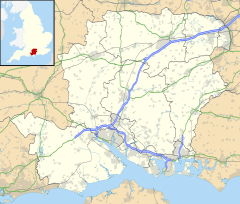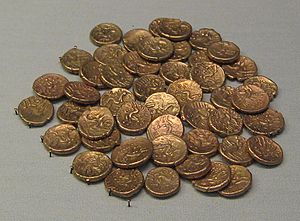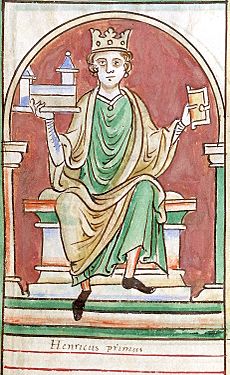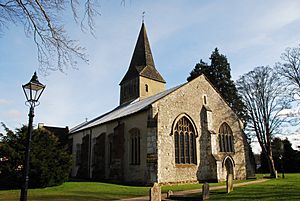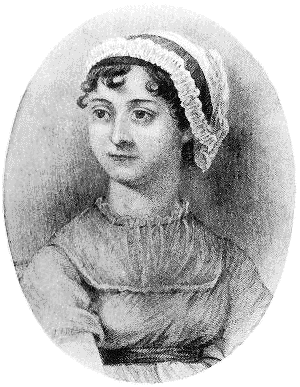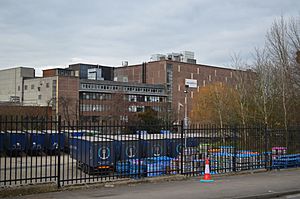Alton, Hampshire facts for kids
Quick facts for kids Alton |
|
|---|---|
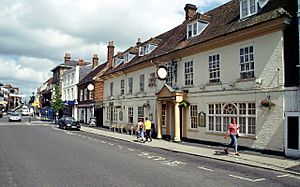 Alton, looking north east along the High Street |
|
| Population | 17,816 (2011 Census) |
| OS grid reference | SU716394 |
| Civil parish |
|
| District |
|
| Shire county | |
| Region | |
| Country | England |
| Sovereign state | United Kingdom |
| Post town | ALTON |
| Postcode district | GU34 |
| Dialling code | 01420 |
| Police | Hampshire |
| Fire | Hampshire |
| Ambulance | South Central |
| EU Parliament | South East England |
| UK Parliament |
|
Alton ( AWL-tən) is a market town and civil parish in the East Hampshire district of Hampshire, England, near the source of the River Wey. It has a population of 17,816 as of the 2011 census.
Alton was recorded in the Domesday Survey of 1086 as Aoltone. During the Saxon period Alton was known as Aweltun. The Battle of Alton occurred in the town during the English Civil War. It also has connections with Sweet Fanny Adams and Jane Austen.
Contents
History
Early history
The Alton Hoard of Iron Age coins and jewellery was found in the vicinity of the town in 1996 and is now in the British Museum. A Roman road ran from Chichester to Silchester and there is evidence of a Roman posting station at Neatham near Alton, probably called Vindomis, and a ford across the River Wey. Centuries later, an Anglo-Saxon settlement was established in the area and a large 7th century cemetery has been discovered during building excavations. It contained a selection of grave goods which included the Alton Buckle which is on display in the Curtis Museum, and is considered to be the finest piece of Anglo Saxon craftsmanship found in Hampshire. The buckle was found in the grave of a warrior, and has a silver-gilt body, set with garnets and glass.
The River Wey has a source in the town, and the name Alton comes from an Anglo-Saxon word "aewielltun" meaning "farmstead at the source of the river".
In 1001 Danish forces invaded England during the First Battle of Alton. When they reached Alton, the forces of Wessex came together and fought against them. About 81 Englishman were killed, including Ethelwerd the King's high-steward, Leofric of Whitchurch, Leofwin the King's high-steward, Wulfhere a bishop's thane, and Godwin of Worthy, Bishop Elfsy's son. Danish casualties were higher, but the Danes won the battle and fleeing Englishmen took refuge in Winchester.
Alton is listed as having the most valuable recorded market in the Domesday Book under the name Aoltone in the 'Odingeton Hundred — Hantescire'.
The Treaty of Alton was an agreement signed in 1101 between William the Conqueror's eldest son Robert, Duke of Normandy and his brother Henry I of England. Henry had seized the throne while his elder brother was away on the first crusade. Robert returned to claim the throne, landing in Portsmouth. The two brothers met in Alton and agreed terms which formed the Treaty of Alton. Part of the main street through Alton is called Normandy Street, probably reflecting this event.
Middle Ages
The first recorded market in Alton was in 1232, although the market at Neatham first recorded in the Domesday Book may also have been in the town. Blome wrote in 1673 of a 'market on Saturdays, which is very great for provisions, where also are sold good store of living cattle'. The Saturday market is featured on Kitchin's map of Hampshire (1751) which marks the town as Alton Mt. Sat.
1307 was, in fact, the first year of Edward II’s reign but Edmund of Woodstock was not lord of the manor then. According to the Victoria County History (written after Curtis’ book):-
- ‘In 1273 Edward I granted the manor [of Alton Westbrook] to his mother, Queen Eleanor, who died in 1291, when it reverted to the Crown and was granted in 1299 as dower to his second wife, Margaret of France. On the death of Queen Margaret in 1317, it again came to the Crown, and Edward II gave it in 1319 to his brother Edmund of Woodstock, Earl of Kent.’
As can be seen, Queen Margaret held the manor until 1317 and so the fair could not have been granted to Edmund of Woodstock in 1307.
The correct date for the grant seems to be 22 November 1320 (according to the Charter Rolls, 14 Edward II, no.15). The grant was for a 9-day fair - the vigil [eve] and feast of Whitsuntide and seven days after.
The two main manors in Alton - Alton Eastbrook and Alton Westbrook - had a fair each. That of Alton Eastbrook has no extant charter, and may never have had one. It was originally held on St Lawrence’s Day and so its origin was, presumably, the patronal festival. The religious aspect would have ceased when the country was no longer Roman Catholic. This fair seems to have been held on Crown Close (which is in the manor of Alton Eastbrook) in the early 19th century. When this land was built upon, the fair moved and was held where ever the Westbrook fair was - the Market Place, various meadows and the Butts.
The date of the Eastbrook fair was changed to Michaelmas in the mid-18th century as it came during harvest time and the farmers were not satisfied. Some accounts for this fair in the early 18th century do survive and show that there was a cheese fair as well the usual mix of travelling and local people with stalls and stands - people selling lace, gloves, books, gingerbread, bodices, sugar plums, toys, soap and knives, to name but a few. By the late 19th century, this fair was said to be mainly for horses, sheep and, occasionally, hops. Alton still has an annual fair, but it now takes the form of a carnival.
Modern period
Eggar's School was founded in 1640 by John Eggar of Moungomeries as the Free Grammar School. It later became known as Eggar's Grammar School. It occupied a site in Anstey Road until it moved to a new site in Holybourne in 1969.
A battle was fought in Alton during the English Civil War. A small Royalist force was quartered in the town when on 13 December 1643 they were surprised by a Parliamentary army of around 5,000 men. The Royalist cavalry fled, leaving Sir Richard Bolle (or Boles) and his infantry to fight. Outnumbered, the Royalists were forced into the Church of St Lawrence, where Bolle was killed along with many of his men. Over 700 Royalist soldiers were captured and bullet holes from the battle are still visible in the church today.
In 1665, Alton suffered an outbreak of bubonic plague, but soon recovered.
Geography
Alton is between Farnham 9 miles (14 km) to the northeast and Winchester 16 miles (26 km) to the southwest. London is 52 miles (84 km). Nearby Brockham Hill, situated 3.5 miles (5.6 kilometres) northeast of Alton, rises to 225 metres (738 feet) above sea level.
The nearby village of Bentworth is the highest village in Hampshire.
Climate
Along with the rest of South East England, Alton has a temperate climate which is generally warmer than the rest of the country. The annual mean temperature is approximately 9 °C (48.2 °F) and shows a seasonal and a diurnal variation. January is the coldest month with mean minimum temperatures between 0.5 °C (32.9 °F) and 2 °C (35.6 °F). June and July are the warmest months in the area with average daily maximum around 25.5 °C (77.9 °F).
Culture
Alton WordFest is a celebration of the spoken and written word held in late September or early October each year. The festival includes writing competitions for children and adults, a children's spelling bee, a literary lunch, book launches and talks by authors and workshops. Since 2010, Alton WordFest has hosted The Pint Pot of Fire - a story-telling competition among champions representing writers' circles, public speaking groups and oral-tradition story-telling clubs from around the area. The Pint Pot of Fire has run annually since 2005 and was formerly held in Guildford (2005) and Farnham (2006–2009).
The Allen Gallery serves as Alton's art gallery. It houses a large, permanent ceramics collection as well as temporary exhibitions.
Holybourne Theatre is on the site of a former Nissen hut that was converted into a theatre by German prisoners-of-war during World War II. Plays have been performed there since 1950, but the official opening was not until 1971.
Alton Morris was formed in 1979, and have been Morris Dancing both in the United Kingdom and abroad. They often perform at Alton street events.
Local choirs include Alton Amateur Operatic and Dramatic Society, established in 1921, who perform two musical shows and one play each year in a wide variety of musical and dramatic styles. Alton Community Choir sings unaccompanied Hampshire folk songs as well as some African, gospel, blues and calypso music.
Notable people
- William de Alton (c. 1330–1400), Dominican Friar, writer and theological philosopher during King Edward II's reign, became famous for asserting that the Virgin Mary was polluted with original sin
- Edmund Spenser (1552–1599), the Elizabethan poet and contemporary of William Shakespeare, may have lived in a now well-preserved Tudor cottage at 1 Amery Street in about 1590. A plaque on the house states that he "lived some time in these parts".
- John Pitts, biographical author, was born in Alton in 1560
- John Murray (1741–1815), born in Alton, a pioneering minister of the Universalist church in the United States.
- William Curtis (1746–1799), botanist, was born in Alton and served his apprenticeship as an apothecary before devoting the rest of his life to the study of British plants.
- Jane Austen (1775–1817), Georgian novelist, lived in Chawton just outside Alton from 1809 until her death, and wrote or revised six novels there.
- Cardinal Newman (1801–1890), English Catholic, lived in Alton from 1816 to 1819.
- William Curtis Green (1875-1960), architect.
- Iona and Peter Opie: Iona Opie (1923–2017) and Peter Opie (1918–1982), folklorists and anthologists famed for their research into children's literature, and street and playground games. Their collection of children's literature has been donated to the Bodleian Library in Oxford.
- James William 'Jimmy' Dickinson (25 April 1925 – 8 November 1982 in Alton), an English football player. Dickinson holds the record number of league appearances for Portsmouth F.C. (764). Only Swindon Town's John Trollope (770) has made more appearances for a single club. His performances earned him a call-up to the England national football team. He won 48 caps for England, making him Portsmouth's most capped English player. During his record 845 club appearances for Pompey and his 48 England caps he was never once booked or sent off, earning him the nickname Gentleman Jim. There was a pub in Alton named after him called The Gentleman Jim.
- Graham Stratford, English cattle breeder, local politician and in 1974 the first Town Mayor of Alton Town Council.
- Alison Goldfrapp (born 1966), singer of Goldfrapp.
- Russell Howard (born 1980), comedian best known for Russell Howard's Good News, studied at Alton College.
Transport
Alton station is on the National Rail network at the end of the Alton line with a service to London Waterloo.
Alton railway station is the terminus for the Watercress Line, formerly the Mid Hants Railway, a restored steam railway running between Alton and New Alresford, so called because it used to be used to transport fresh watercress to London. The Watercress Line is now a charity largely operated by volunteers, and best known for its events such as Steam Illuminations, War on the Line and Day Out With Thomas featuring Thomas The Tank Engine.
The origins of the Watercress Line date back to 1861, the year in which Parliament granted consent for what was then known as the 'Alton, Alresford and Winchester Railway'. Four years later the Mid Hants Railway opened, and the train service continued until the line was closed in 1973. Then in 1977 the line was partially re-opened, in 1983 it was extended further, and in 1985 it was re-opened as far as Alton to connect with the mainline London service.
Alton used to be a railway junction. As well as the Mid-Hants Railway, from 1903 to 1955 the Meon Valley Railway ran from Alton down the Meon Valley to join the Eastleigh to Fareham line at Fareham. The Basingstoke and Alton Light Railway ran north to Basingstoke.
In 2015 some passenger buses in the Alton area were operated by Stagecoach South.
Twin towns
Alton is twinned with:
 Pertuis, Vaucluse, Provence-Alpes-Côte d'Azur, France
Pertuis, Vaucluse, Provence-Alpes-Côte d'Azur, France Montecchio Maggiore, Vicenza, Veneto, Italy
Montecchio Maggiore, Vicenza, Veneto, Italy
Nearest places
 |
Shalden Lasham |
Golden Pot | Holybourne Bentley |
 |
| Bentworth | East Worldham | |||
| Four Marks | Chawton Upper Farringdon |
Selborne |
- Alton in the Domesday Book
Economy
There have been a number of breweries in Alton since 1763. Coors Brewing Company (among the ten largest brewers in the world) had a brewery in Alton for fifty years, which produced Carling, Grolsch and Worthington. It closed in 2015 because it lost work from Heineken.
Alton was significant in the 18th century for the manufacture of paper and of dress materials including ribbed druggets, shallons, silks and serges, bombazine and figured barragons.
Alton has businesses in the retail and service sectors in the centre of the town, and over a hundred businesses in the four industrial areas of Mill Lane, Newman Lane, Caker Stream and Omega Park, ranging from light industrial to computer software production. Clarcor, TNT N.V. and Poseidon Diving Systems all have businesses in Alton's Industrial Site, Mill Lane.
One of Alton's largest commercial employers is the financial services sector. Lumbry Park, which used to be known as Lumbry Farm, is on the B3006 Alton to Selborne road, and is occupied by Inter Group Insurance Services (IGIS), a subsidiary of The Royal Bank of Scotland. Inter Group employs over 170 people on this site, and specialises in travel insurance. The company has operated in Alton since 1999. It was acquired by Churchill Insurance in 2001, becoming part of RBS Insurance division in 2003 as part of an RBS takeover. However, on 11 November 2008, Inter Group announced its proposal to close its office in Alton in August 2009 due to "changes in the travel insurance market", leading to the loss of 104 full-time staff and around 16 part-timers. The head of Inter Group, Bob Andrews, said that the decision to close the Alton site had been forced by "a fundamental shift in the third-party travel insurance market in the last few years" and that "Major clients of Inter Group have recently taken their travel insurance business back in-house and sadly we have no alternative but to make this announcement today". He said, "We have explored every possible avenue before proposing this unfortunate action."
Alton has a range of chain stores and independent shops including greengrocers, butchers and a hardware shop. There are five main supermarkets that serve the town.
Education
Alton lies approximately midway between the University of Winchester and the University of Surrey at Guildford but its nearest University campus is the University for the Creative Arts in Farnham. It is home to Treloar's, an independent educational establishment founded in 1907 by Sir William Purdie Treloar, Lord Mayor of London, to provide education for young people with physical disabilities. Treloar's now runs Treloar School and College, a provision of education for pupils aged from 2–25 with physical and learning difficulties in Holybourne. Treloar's provides specialist facilities, therapy and medical care to enable pupils to achieve their academic potential and develop their confidence and independence. Former pupils include comedian and actor Spike Breakwell, actress Julie Fernandez, mouth and foot painting artist Tom Yendell.
The State secondary schools in Alton are Eggar's School (formerly the Grammar School), and Amery Hill School. There is an independent Catholic day school, Alton School (formerly Alton Convent School), which educates boys and girls from 6 months to 18 years old. Sixth-form education is provided by Alton College, which has gained outstanding inspection reports from Ofsted.
Images for kids
See also
 In Spanish: Alton (Hampshire) para niños
In Spanish: Alton (Hampshire) para niños


